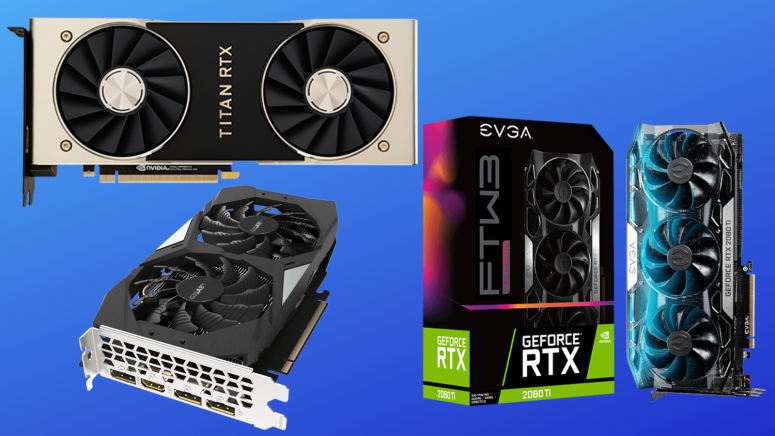
The Best NVIDIA GPUs to Buy in 2020 — Game Like a Pro
NVIDIA GPUs are undoubtedly the best when it comes to pure gaming performance, and, thanks to the most recent Turing architecture, gamers now have a range of options to choose from. Depending on the budget, of course.
Turing graphics cards are a major improvement over the previous Pascal generation. The high-end ones that belong to the RTX family include support for real-time ray tracing for games and AI tools to optimize the game quality without putting too much of a load on the GPU. These features come as premium, so the NVIDIA RTX cards are priced higher than competing offerings from AMD.
However, NVIDIA still recognizes that most gamers prefer to purchase GPUs in the $200 to $400 range and hence introduced the GTX series without the ray tracing and DLSS features. There is only a handful of games that support these advanced graphics features, and they even look just fine with these turned off.
Listed below are the 13 best NVIDIA GPUs to buy 2020, right from the mighty Titan RTX to the very humble GTX 1650.
1. NVIDIA Titan RTX
- CUDA Cores: 4,608
- RT / Tensor Cores: 72 / 576
- GPU Clock (Base/Boost): 1,350 / 1,770 MHz
- Memory Type: 384-bit 24 GB GDDR6
- Memory Bandwidth: 672 GB/s
- TDP: 280 W
- Ports: 3x DisplayPort; 1x HDMI; 1x USB Type-C
The NVIDIA Titan RTX is easily one of the best NVIDIA GPUs you can buy today for deep learning and AI accelerated workloads. The Titan RTX is similar to the RTX 2080 Ti but comes with a full-specced TU102 GPU with 4,608 CUDA cores, 72 RT cores, and 576 Tensor cores. Although the Titan RTX can game well, it is not just for gamers. With a single-precision performance of up to 16.3 TFLOPs, the card is better suited for those working in the fields of data science, AI, and machine learning. Therefore, the Titan RTX is only available as a Founders Edition card directly from NVIDIA, unlike the other consumer GPUs.
The Titan RTX comes with 24 GB of GDDR6 VRAM with a bandwidth of a whopping 672 GB/s. You can combine this with another Titan RTX via the provided NVLink connector to get up to 48 GB of VRAM and 100 GB/s total bandwidth. The Titan RTX is not cheap but is a good choice over the Quadro lineup if you are working on deep learning and creative workloads.
- Pros: Excellent performance; Great for AI workloads
- Cons: Very expensive
2. EVGA GeForce RTX 2080 Ti FTW3 Ultra
- CUDA Cores: 4,352
- RT / Tensor Cores: 68 / 544
- GPU Clock (Base/Boost): 1,350 / 1,755 MHz
- Memory Type: 352-bit 11 GB GDDR6
- Memory Bandwidth: 616 GB/s
- TDP: 250 W
- Ports: 3x DisplayPort; 1x HDMI; 1x USB Type-C
The NVIDIA RTX 2080 Ti is the next GPU in the Turing lineup and is currently the best NVIDIA GPU you can get for gaming. The EVGA GeForce RTX 2080 Ti FTW3 Ultra is among the best AIB cards you can get for the RTX 2080 Ti GPU. The FTW3 sports a custom PCB with a 16-phase VRM and a dual-BIOS. Although the RTX 2080 Ti has a 250 W TDP, the EVGA card has a power limit of up to 300 W, allowing enough headroom for overclocking. Like the RTX Titan, the RTX 2080 Ti is also based on the TU102 chip. However, compared to the former, we see reduced CUDA, RT, and Tensor cores. Still, the presence of a generous 68 RT core should allow for good performance in games with support for ray-traced shadows and global illumination.
The EVGA RTX 2080 Ti FTW3 Ultra comes with an excellent thermal solution featuring three fans. Due to the additional thermal headroom, the FTW3 Ultra runs at a boost clock of 1,755 MHz compared to the 1,545 boost of the Founder's Edition. It does not show a very significant bump in overall performance, but overclockers will be happy to extract all the performance they can from this card. Switching over to the OC BIOS gives you a more aggressive fan curve for better cooling, with a slight increase in operating noise. A neat feature is that you can connect your case fans to the card via a dedicated fan header so that all fans in the case match that of the GPU. If you are looking for the best RTX 2080 Ti implementation, look no further than the EVGA RTX 2080 Ti FTW3 Ultra.
- Pros: Increased power limits; Custom PCB; Dual-BIOS
- Cons: Not much performance benefit with overclocking
3. Gigabyte Aorus GeForce RTX 2080 Super 8G
- CUDA Cores: 3,072
- RT / Tensor Cores: 48 / 384
- GPU Clock (Base/Boost): 1,650 / 1,860 MHz
- Memory Type: 256-bit 8 GB GDDR6
- Memory Bandwidth: 496 GB/s
- TDP: 250 W
- Ports: 3x DisplayPort; 1x HDMI; 1x USB Type-C
The Gigabyte Aorus GeForce RTX 2080 Super 8G is the card to opt for when you are not gaming at 4K with RTX on. The RTX 2080 Super is the perfect card if you are primarily gaming at 1440p at Ultra settings. The Aorus RTX 2080 Super is a 2.5-slot card that uses Gigabyte's Windforce 3x cooling system. In this setup, the middle fan rotates in the opposite direction of the other two fans resulting in better airflow and efficient heat dissipation. The GPU operates fairly quietly, and the fans are hardly audible even under full load. Like another premium NVIDIA GPUs, the Aorus GeForce RTX 2080 8G sports three DisplayPort-outs, an HDMI-out, and a USB Type-C VR Link connector for connecting VR headsets. Gigabyte also offers a good dose of RGB on the fan rims that can be controlled via the Aorus Engine software.
The RTX 2080 Super is an interesting part of the NVIDIA GPU lineup. While it does not really offer much of a significant performance boost over the RTX 2080, it sells for a slight premium over the RTX 2080. However, if you are in the market for the best NVIDIA GPU that can game at 1440p, the RTX 2080 Super does not have much competition.
- Pros: Great for 1440p Ultra gaming
- Cons: Expensive; Not really a worthy upgrade over the RTX 2080
4. Asus ROG Strix GeForce RTX 2080 OC Edition
- CUDA Cores: 2,944
- RT / Tensor Cores: 46 / 368
- GPU Clock (Base/Boost): 1,515 / 1,860 MHz
- Memory Type: 256-bit 8 GB GDDR6
- Memory Bandwidth: 448 GB/s
- TDP: 215 W
- Ports: 2x DisplayPort; 2x HDMI; 1x USB Type-C
If the RTX 2080 Super feels a bit expensive for the features on offer, consider the RTX 2080 GPU. Although NVIDIA has stopped production of the RTX 2080 to promote the RTX 2080 Super, you can still get cards such as the Asus ROG Strix RTX 2080 OC Edition from most retailers. The RTX 2080 is also now available at a reduced price, making it a compelling purchase. The Asus RTX 2080 is overclocked to 1,860 MHz out-of-the-box. It features a triple-fan setup for efficient cooling and offers all expected ports, including VR Link. Users who prefer HDMI over DisplayPort will be happy to know that this NVIDIA GPU offers two HDMI ports. Asus also offers a BIOS switch to toggle between Quiet and Performance modes easily.
The Asus ROG Strix RTX 2080 OC Edition comes with a decent RGB lighting system — it's not overly flashy but looks prominent enough. Asus also offers an RGB header that can accommodate additional LED strips. All of these can be controlled via Asus's Aura Sync software. The robust cooling ensures that temperatures are kept under a manageable 70 degrees under most loads. If the Asus card seems a little expensive, you can also check out other OEMs that offer the RTX 2080 NVIDIA GPU, such as EVGA, Galax, Inno3D, etc. and save a little bit of cash.
- Pros: 2 HDMI ports; Great for 1440p gaming; Good OC potential
- Cons: Expensive than other brands
5. MSI GeForce RTX 2070 Super Gaming Z Trio
- CUDA Cores: 2,560
- RT / Tensor Cores: 40 / 320
- GPU Clock (Base/Boost): 1,605 / 1,800 MHz
- Memory Type: 256-bit 8 GB GDDR6
- Memory Bandwidth: 448 GB/s
- TDP: 215 W
- Ports: 3x DisplayPort; 1x HDMI
The MSI Gaming Trio series is known for its reliability and robust cooling setup. MSI offers two types of cards under the Trio series — Gaming X and Gaming Z, with the Gaming Z series offering a slightly higher boost clock. The RTX 2070 Super Gaming Z Trio offers a higher boost than the reference NVIDIA GPU and comes with a faster memory as well. The RTX 2070 Super offers a 256-bit 8 GB GDDR6 VRAM, which should allow for better handling of heavy game textures. The premium design of the Gaming Z Trio will compliment most gaming rigs, and there is some RGB thrown in for those who prefer it.
At high loads, the RTX 2070 Super Gaming Z Trio heats up to less than 70 degrees, which is highly welcome. The fans can be configured to run as quiet as possible, and there is no coil whine. Overclockers will find enough flexibility with the card when using software such as MSI Afterburner. The MSI RTX 2070 Super can play a very well game at 4K under appropriate game setting, but this is one of the best NVIDIA GPUs to buy if you want good ray tracing at 1080p or 1440p without losing much performance.
- Pros: Premium looks; Good performance
- Cons: More expensive than a reference card
6. EVGA GeForce RTX 2070 XC Ultra Gaming
- CUDA Cores: 2,304
- RT / Tensor Cores: 36 / 288
- GPU Clock (Base/Boost): 1,410 / 1,725 MHz
- Memory Type: 256-bit 8 GB GDDR6
- Memory Bandwidth: 448 GB/s
- TDP: 215 W
- Ports: 3x DisplayPort; 1x HDMI; 1x USB Type-C
While NVIDIA now sells only the RTX 2070 Super, you can still find RTX 2070 GPUs at many vendors. However, pricing should be taken into account as some cards are still being sold at a premium. The EVGA GeForce RTX 2070 XC Ultra Gaming is one such GPU. As with most EVGA cards, the RTX 2070 XC is very different from the reference cards from NVIDIA and comes with an efficient dual-fan cooling system. The card's shroud does raise a few eyebrows, but we feel that complements a gaming rig quite nicely. EVGA offers the Precision X1 utility that allows you to control aspects of the card, such as voltage, power limit, and temperature. If you know what you are doing, you can extract a decent amount of extra overclocking performance from this GPU.
The EVGA GeForce RTX 2070 XC Ultra makes for one of the best NVIDIA GPUs for entry-level 4K gaming although, it is more suited for playing at 1440p or 1080p at high frame rates. While handling most AAA games is a breeze for this card, it does not have as many RT cores as the higher variants, so enabling ray tracing can cause quite a performance loss.
- Pros: Good looks; Excellent software control
- Cons: Expensive
7. Gigabyte GeForce RTX 2060 Super Gaming OC
- CUDA Cores: 2,176
- RT / Tensor Cores: 34/ 272
- GPU Clock (Base/Boost): 1,470 / 1,815 MHz
- Memory Type: 256-bit 8 GB GDDR6
- Memory Bandwidth: 448 GB/s
- TDP: 160 W
- Ports: 3x DisplayPort; 1x HDMI; 1x USB Type-C
The Gigabyte GeForce RTX 2060 Super Gaming OC is a dual-slot card that uses the latest NVIDIA RTX 2060 Super GPU. Gigabyte uses slightly different specs from the reference cards with this card, offering a boost clock up to 1,815 MHz. Connectivity options include three DisplayPort 1.4 ports, one HDMI 2.0b, and one USB Type-C that supports VR. Unlike the RTX 2070 and above cards, the RTX 2060 Super does not offer the NVLink bridge to link two such cards in an SLI setup. Gigabyte uses its Windforce 3X cooling system that is comprised of a triple-fan set up with the center fan rotating in the opposite direction for more uniform airflow. The card's heatsink covers the VRAM, VRMs, and the GPU itself. The RGB is limited to the Gigabyte logo, but it would have been better if the GeForce RTX logo was made RGB instead of the brand name. An 8+6 power connector powers the card.
The Gigabyte GeForce RTX 2060 Super Gaming OC is one of the best NVIDIA GPUs for 1080p Ultra/1440p High gaming. This is a great option if you are primarily looking for high performance in games such as Apex Legends, Overwatch, and CS: GO at 1080p. The Gigabyte offering is much better than the NVIDIA Founders Edition of the same GPU as the former has better cooling and a higher boost clock. On top of that, Gigabyte also offers a four-year warranty on the card, which is a real bonus for the price.
- Pros: Great for 1080p Ultra gaming; Good cooling
- Cons: None as such
8. EVGA GeForce RTX 2060 KO Gaming
- CUDA Cores: 1,920
- RT / Tensor Cores: 30 / 240
- GPU Clock (Base/Boost): 1,365 / 1,680 MHz
- Memory Type: 192-bit 6 GB GDDR6
- Memory Bandwidth: 336 GB/s
- TDP: 160 W
- Ports: 1x DisplayPort; 1x HDMI; 1x DVI-D
The NVIDIA RTX GPUs have been traditionally priced at a higher tier due to the availability of ray tracing and AI features, but the EVGA GeForce RTX 2060 KO Gaming seeks to change that. The RTX 2060 KO retails for just about $300, making it a compelling choice for those who want to test waters with the RTX lineup. An interesting aspect of the RTX 2060 KO is that it is based on the same TU104 GPU that is found in the more expensive RTX 2080 NVIDIA GPUs and not the TU106 that has traditionally been called the RTX 2060. However, the TU104 in the EVGA RTX 2060 KO has been cut-down to match the RTX 2060's specs, which means on paper, the number of CUDA cores, and type of memory support is exactly the same as the RTX 2060. While performance difference in games is not much different from the previous RTX 2060 cards we've seen so far, the RTX 2060 KO does work great when it comes to compute-intensive tasks.
The EVGA RTX 2060 KO is built around the same construction and cooling as the EVGA GeForce RTX 1660 Super PC to save costs. Unlike many other RTX cards, the RTX 2060 KO sports only one DisplayPort, one HDMI, and a DVI-D port — there is no USB Type-C here. The card can be slightly overclocked using EVGA's Precision X1 tool, but there are power limits enforced to prevent the VRMs from getting overloaded. Overall, if you are looking to get your hands on an NVIDIA RTX GPU but don't want to splurge, the EVGA RTX 2060 KO is one of the best cheapest RTX GPUs available.
- Pros: Affordable; Good for computing tasks
- Cons: None as such
9. Gigabyte GeForce GTX 1660 Ti OC
- CUDA Cores: 1,536
- RT / Tensor Cores: N/A
- GPU Clock (Base/Boost): 1,500 / 1,860 MHz
- Memory Type: 192-bit 6 GB GDDR6
- Memory Bandwidth: 288 GB/s
- TDP: 120 W
- Ports: 2x DisplayPort; 2x HDMI
While real-time ray tracing is good to have in a GPU, it is a computationally-intensive process, and there aren't too many games that support it despite NVIDIA launching RTX cards for nearly two years ago. If you aren't worried much about ray tracing and DLSS features, you can save quite a bit of money by opting for the GTX series and still get good performance. The GeForce GTX 1660 Ti is the among the best NVIDIA GTX GPUs even if it sacrifices a good number of CUDA cores and RT/Tensor cores for a traditional shader design model. The GTX 1660 Ti is the latest and most powerful among the Turing GTX series, and the Gigabyte GeForce GTX 1660 Ti OC offers a substantial boost clock of 1,860 MHz. The Gigabyte GeForce GTX 1660 Ti OC uses an 80mm triple-fan cooling setup and a 4+2 phase VRM.
This Gigabyte card does not offer any fancy RGB lighting apart from the logo and also foregoes some of the niceties such as the VRLink connector. However, it performs as expected, and the factory-overclock is a nice boost. Temperatures hardly 65 degrees under load, which means you don't have to worry much about throttling. This is one of the best NVIDIA GPUs you can get for 1080p Ultra gaming without ray tracing enabled. You can also push it to 1440p if you manage to tone down some of the in-game details.
- Pros: Excellent performance for the price; Factory-overclocked
- Cons: None as such
10. MSI GeForce GTX 1660 Super Gaming X
- CUDA Cores: 1,408
- RT / Tensor Cores: N/A
- GPU Clock (Base/Boost): 1,530 / 1,785 MHz
- Memory Type: 192-bit 6 GB GDDR6
- Memory Bandwidth: 336 GB/s
- TDP: 125 W
- Ports: 3x DisplayPort; 2x HDMI
The GeForce GTX 1660 Super is an improved version of the original GTX 1660 GPU with increased memory bandwidth. The GTX 1660 Super is great for modern AAA 1080p gaming between medium to high settings. The NVIDIA GTX 1660 Super performs almost identical to the 1660 Ti and comes with faster memory. The 1660 Ti has the advantage of having more CUDA Cores, however. The MSI GeForce GTX 1660 Super Gaming X is the first such card to be available as there is no Founders Edition for the GTX 1660 Super. MSI uses a twin FROZR 7 cooler to keep the card cool, and like every other Gaming X card, it comes with a backplate to make it look pleasing. There are three DisplayPort 1.4 connectors and an HDMI 2.0 connector provided. There is no USB Type-C or DVI-D port available.
The MSI GeForce GTX 1660 Super Gaming X has a pretty robust cooling system. The GTX 1660 Super is relatively easier to cool than the RTX GPUs, and the card's fans don't turn on till the chip hits the 60 degrees mark. Of course, you can set custom fan curves using MSI Afterburner or any such similar software. The GDDR6 memory on the 1660 Super is a much better performer than the GDDR5 on the original GTX 1660, so memory-intensive games should perform comparatively better. Overall, if you are looking for some no-frills attached 1080p or even 1440p gaming, the MSI GeForce GTX 1660 Super Gaming X is one of the best NVIDIA GPUs for the price.
- Pros: Good cooling and overall performance
- Cons: None as such
11. Zotac GeForce GTX 1660
- CUDA Cores: 1,408
- RT / Tensor Cores: N/A
- GPU Clock (Base/Boost): 1,530 / 1,785 MHz
- Memory Type: 192-bit 6 GB GDDR5
- Memory Bandwidth: 192.1 GB/s
- TDP: 120 W
- Ports: 3x DisplayPort; 1x HDMI
If you do not wish to spend more than $200 for GPU, the Zotac GeForce GTX 1660 is one of the best NVIDIA GPUs for the task. The GTX 1660 uses the latest NVIDIA Turing architecture but does not feature goodies such as ray tracing and DLSS. This should not be much of an issue as there are not many games that make use of these features. Compared to its successor, the GTX 1660 Super, the GTX 1660 uses a lower speed memory and has a TDP of just 120W. While there are AiB cards that have just a single fan for the GTX 1660, Zotac offers a twin-fan system for added cooling. There is no fancy RGB setup involved, and Zotac sticks to a largely reference design and clocks. Unlike the GTX 1660 Super, the original 1660 makes do with just GDDR5 memory. It will not matter much if you don't run games that are memory intensive, which includes most games that are a few years old.
The Zotac GeForce GTX 1660 runs pretty coolly even at high load, with the card peaking at about 65 degrees C on average. Zotac's twin-fan system does a great job, but the fans can be quite audible when constantly spinning. Although Zotac has managed to extract the maximum possible from the Turing chip, there is still some scope for overclocking, which can be easily accomplished by third-party utilities or via Zotac's own Firestorm software. For those who need a decent GPU without spending north of $200, the Zotac GeForce GTX 1660 will fit the bill perfectly.
- Pros: Decent performance; No heating issues; Affordable
- Cons: None as such
12. Zotac GeForce GTX 1650 Super
- CUDA Cores: 1,280
- RT / Tensor Cores: N/A
- GPU Clock (Base/Boost): 1,530 / 1,725 MHz
- Memory Type: 128-bit 4 GB GDDR6
- Memory Bandwidth: 192 GB/s
- TDP: 100 W
- Ports: 1x DisplayPort; 1x HDMI; 1x DVI-D
We are now entering into the lowest segment in the Turing lineup with the GTX 1650 Super. The GeForce GTX 1650 Super is a recent launch that upgrades some of the bottlenecks of the GTX 1650, such as moving to GDDR6 memory and offering a higher memory bandwidth. Apart from this, the GTX 1650 Super is very much identical to the original GTX 1650. Zotac once again offers a compelling GeForce GTX 1650 Super card that ticks all the boxes for a capable best budget GPU. Like many other GTX Turing cards, the GTX 1650 Super does not have a reference card from NVIDIA, so you will have to choose from one of the several AiB partner options available from Zotac, MSI, Asus, and Gigabyte. The Zotac GeForce GTX 1650 Super sports a twin-fan setup that should offer great cooling performance to something that already runs cool on its own. However, the increased memory bandwidth does make it consume more power at a 100W TDP. The compact size of the card makes it amenable to small HTPC systems without much fuss. Connectivity is ensured via a DisplayPort 1.4, HDMI, and a DVI-D port.
The Zotac GeForce GTX 1650 Super does allow for a fairly decent overclock but don't expect too much of a headroom. The GTX 1650 Super is just about right if you are primarily a 1080p gamer, who plays somewhat older AAA titles such as Tomb Raider (2013), CS: GO, Rainbow Six: Siege, or Bioshock: Infinite. For newer titles, you may have to dial down some of the visual settings to stay consistently above the 60 fps mark. If you can live with that, the Zotac GeForce GTX 1650 Super is one of the best gaming GPUs under $160 and punches far above its weight.
- Pros: Good price-to-performance ratio; Runs cool
- Cons: None as such
13. Asus Phoenix GeForce GTX 1650 OC Edition
- CUDA Cores: 896
- RT / Tensor Cores: N/A
- GPU Clock (Base/Boost): 1,485 / 1,710 MHz
- Memory Type: 128-bit 4 GB GDDR5
- Memory Bandwidth: 128 GB/s
- TDP: 75 W
- Ports: 3x DisplayPort; 1x HDMI; 1x DVI-D
Finally, at the entry-level of the NVIDIA Turing family, we have the Asus Phoenix GeForce GTX 1650 OC based on the TU117 GTX 1650 NVIDIA GPU. For GTX 1650 is a humble card that features just 896 CUDA cores, 4 GB of GDDR5 RAM, and runs at a TDP of just 75W. A single double-ball bearing fan helps keep the temperatures low. Moreover, the shroud is open on all sides, so ventilation is not really an issue with the Phoenix GTX 1650. This card does not even need external power as it can directly run off the PCIe slot. Port selection is like any other budget NVIDIA GPU — you get one of DisplayPort 1.4, HDMI 2.0, and DVI-D each.
Given the fairly modest specs, expecting to play the latest AAA titles at FHD Ultra is a little far-fetched for this GPU. However, if you can work around the in-game settings a bit, most titles will be able to hit at least 50 fps. Needless to say, the older the game, the lower is the strain on the card. That being said, we would recommend going for at least a 1660 series card if you would like to have a better gaming experience. The GTX 1650, however, is fine for the casual gamer or the multimedia enthusiast. The low power requirements and a decent gaming performance mean that the Asus Phoenix GeForce GTX 1650 OC is the best cheapest NVIDIA GPU for gaming — if you can still find one, that is.
- Pros: Decent gaming at FHD; Affordable
- Cons: None as such
Dear readers, that was our roundup of all the NVIDIA GPUs available for gamers across budgets. Remember that you will get the best bang for your buck if you can decide on the kind of workloads you'll be subjected to the GPU too. As always, feel free to let us know your comments and queries below.












